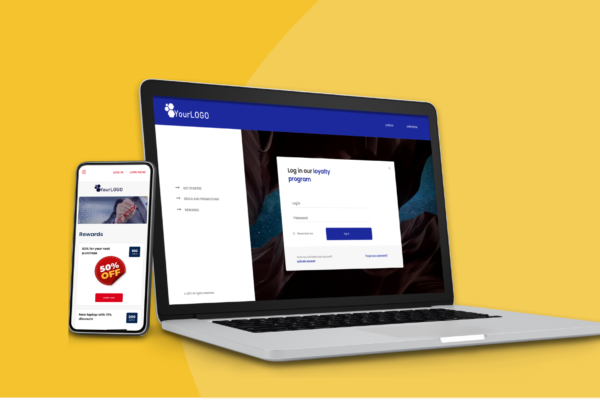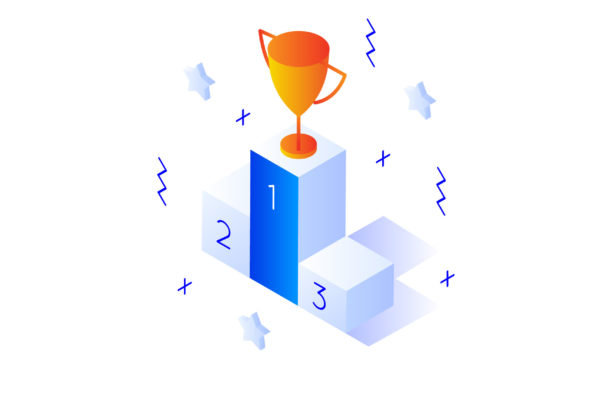Loyalty programs are phenomenal tools to reward your customers, encourage them to further engage with your business, and retain customers for longer periods. The mechanics used in business-to-consumer (B2C) loyalty programs can also be useful within the context of business-to-business (B2B) applications. So, what exactly is a business-to-business loyalty program, how is it different from a business-to-customer loyalty program, and what does a successful B2B loyalty program look like? In this article, we’ll answer all of these questions and more.
What Is a B2B Loyalty Program?
A B2B (or business-to-business) loyalty program helps establish loyalty between you and the businesses that make up your target audience. The target audience of B2B loyalty programs might be a company that buys and sells your products (your distributor) or professionals who you partner with in your industry, offering sales incentives and other B2B rewards for engaging with your business.
Some examples include:
- Distributors
- Channel partners and resellers
- Salespeople who work with your reseller company (this would be a sales incentive program)
- Professionals who use your products daily or make purchasing decisions (e.g., architects, construction contractors, or technical installation professionals)
The motives behind launching B2B loyalty programs are the same as with customer loyalty programs. Acquiring new customers is important, but maintaining a good relationship with an existing customer is even better. According to Harvard Business Review, acquiring a new customer can cost anywhere from “five to 25 times more” than retaining an existing customer.
With a B2B rewards program, you can encourage your business members to continue doing business with you over your competitors. By engaging your business partners, sharing knowledge with them, and using B2B rewards as incentives, you can quickly boost sales at lower a cost (compared to acquiring new channel partners or distributors).
B2B vs. B2C — What’s Different and What’s the Same?
You’ve likely seen a lot of customer loyalty programs for businesses that you personally shop with. It seems like every business has one now. However, this is much less common in the B2B world. So what’s the difference between the two? How are they similar? How are rewards different for each?
What Is the Difference between B2C and B2B Loyalty Programs?
- There are typically fewer members in B2B loyalty programs than customer loyalty programs because the qualifications to access the program are often very particular and the target audience is simply smaller.
- While customer loyalty programs are designed around what an individual customer wants, B2B loyalty programs are designed to meet the needs of an entire organization. This takes into account the future plans of the business, the goals of its decision-makers, and its unique industry requirements. For this reason, it can be more difficult to create B2B rewards that are appealing to the target audience.
- As mentioned in the previous point, B2B rewards must be tailored to the specific needs of the program members, which means that B2B loyalty rewards are more personalized and often are more valuable.
- The sales department is closely connected with the loyalty program, motivating customers to join and providing insight into which benefits customers find appealing.
- The value of the rewards that participants receive with B2B loyalty programs is usually smaller. Channel loyalty programs return 2% to 4% of the value to program participants and customer loyalty programs return about 7% to 10%.
- B2B sales incentive programs can be used as content distribution platforms for personalized training programs, training and activating channel partners and distributors.
What Do They Have in Common?
- When it comes to marketing loyalty programs, the strategies for B2B customers and B2C customers are similar. Email marketing or seasonal promotions are effective.
- Time-limited promotions can also be very useful in encouraging users to engage in either business-to-consumer or business-to-business incentive programs.
- Both types of loyalty programs have similar traits that make them successful and attractive to members. Customer and business loyalty platforms should be intuitive and engaging for members, featuring rewards that the target audience values.
Rewards in B2C vs. B2B Loyalty Programs
When it comes to rewards, everyone appreciates a discount or free products. Whether it’s a buy-one-get-one deal or coupons after a customer spends a certain amount, it’s appealing to both B2B and B2C audiences.
However, some rewards in B2B loyalty programs should look different from customer loyalty programs. Businesses love rewards that help to make more money. This might be free training for employees so that they can serve a new audience, free equipment (e.g., tools), or marketing support. Or, it might be discounted upgrades to outdated products, where new products offer innovative features.
Popular sales incentive rewards include prepaid debit cards with funds or gift cards. These types of B2B rewards are only possible in channel loyalty programs because the value can be higher.
Whatever helps them offer new services or features that bring extra cash into their business, that’s an appealing reward for a business member.
B2B Loyalty Programs — Best Practices
To get the most from your B2B loyalty program, there are some best practices you can follow. From the planning phase to the designing phase and through to implementation, use these tips to ensure that your members are receiving the full benefits of your program:
- Decide on Your Goal
Before you do anything else to develop your B2B incentive program, decide on an end goal. Do you want to encourage loyalty? If so, a perks program where members gain access to benefits immediately may be best. Do you want to incentivize higher engagement and more purchases? Create a loyalty program with a points system. Do you want to increase sales of a particular item? Establish sales incentives that reward salespeople within your reseller companies.
Once you’ve decided on your goal, keep it in mind during the entire design process. Everything should work toward achieving that goal.
- Keep it Simple
Your rewards program should be simple to use. If it’s not clear how the customer can benefit from the program, or if it takes too much time and energy to receive the benefits, then your customer will likely lose interest.
- Use Tiers
When you incorporate tiers into your loyalty program, you reward your most active customers. Tiers are usually based on how much money a customer spends within a certain timeframe. The more they spend, the higher the tier, the greater the rewards. This encourages even more purchases and engagement in the future.
- Be Fair
First and foremost, an incentive program should be a benefit to your customers. So, be fair, and prioritize their experience. Show your loyalty toward them and make it easy to work together.
If you can avoid it, don’t change up the rules or structure of the loyalty program. For instance, if they spend $1,000 to receive a $40 discount, don’t change the limit to $2,000 at the last minute. If you absolutely must change the rules, give the customers advance notice and consider offering additional bonuses to keep customers happy.
- Connect it to Other Benefits
Provide sales incentives to members for things like completing training courses or watching videos about your latest product/service. They benefit by getting “free” points. You benefit because they are learning about other products and services that you could potentially upsell them on. If they learn something valuable in a training course or find a lot of value in a new product/service, they’ll feel even more loyal to you for it.
- Analyze Member Segments
Analyze member segments by requesting certain information about the customer when they join the rewards program. With this information, you can ensure that your biggest members aren’t the only ones receiving rewards. You can create benefits specifically for small- to medium-sized members.
- Prioritize Ease of Use
When designing your B2B loyalty program and user portal, prioritize ease of use and intuitiveness for the customer. If your program is not easy to use, it doesn’t matter how great the rewards are, customers won’t want to use it.
Make the essential features easy to find and easy to navigate. Also, provide contact information or help request forms in a central area so users can easily ask questions if necessary.
3 Examples of Successful B2B Loyalty Programs
Loyalty program Example 1 – Fronius
It’s a great example of a B2B loyalty program in a manufacturing industry. Fronius, an Austrian manufacturer of inverters and other solar energy equipment, offers a great example of a loyalty program for a manufacturing company. It includes the typical rewards but also additional benefits that their business partners, installers, and customers love.
Customers who are registered in their program gain access to an extended guarantee on their solar inverters and can view exclusive content. If you’re an installer or reseller, you can also use an exclusive discussion forum to ask questions and connect with others. People who post in the forum gain additional rewards points for each post.
Example 2 – A loyalty program in construction industry
Another good example of a loyalty program for a manufacturing company from the construction industry comes from an international piping and hydraulic equipment manufacturer. They launched this program during a trade show. When people enrolled and signed up for the newsletter, they were granted points immediately.
This was a very effective strategy, resulting in over 700 members enrolling during the trade fair. The program also grew to offer specialized training for members, a great incentive for business members looking to expand their offerings and make more money. The most popular rewards in the program were branded and specialized tools used in the piping industry. Members could “buy” them with their rewards points, essentially getting them for free.
Example 3 – A B2B loyalty program in a manufacturing company
KFA, a bathroom plumbing equipment manufacturer, organized a loyalty program for trade businesses that purchased their goods for construction and remodeling jobs. Because the goods are sold in various retail stores and from other distributors, KFA can’t directly keep track of which members have purchased their items.
To overcome this obstacle, they created a claim form so that loyalty program members could submit a claim any time they bought a KFA product. Users can upload an invoice or receipt to prove their purchase and receive rewards.
Not only did this help overcome an obstacle, but KFA could then connect with members based on the types of products they purchase. This allows for specialized rewards like discounts on relevant equipment or gift cards to stores that the member frequents.
Closing
With all the incentives that members can receive, B2B loyalty programs are excellent tools to encourage engagement from your audience and reward their loyalty to your business. If you don’t already have a rewards system in place for your business customers, consider designing one now. Not only will it make your audience more satisfied with your business but it can also help to increase sales and maintain positive member relationships. When both you and your customers benefit from a B2B loyalty program, there’s no sense in waiting.




